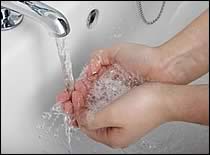PERSONAL HYGIENE AND HANDWASHING AFTER A DISASTER OR EMERGENCY
Good basic personal hygiene and handwashing are critical to help prevent the spread of illness and disease. Clean, safe running water is essential for proper hygiene and handwashing.
Hygiene is especially important in an emergency such as a flood, hurricane, or earthquake, but finding clean, safe running water can sometimes be difficult. The following information will help to ensure good hygiene and handwashing in the event of an emergency.
Disaster Supplies Kit (Hygiene Supplies)
- Before an emergency, make sure you have created a Disaster Supplies Kit.
Handwashing
Keeping hands clean during an emergency helps prevent the spread of germs. If your tap water is not safe to use, wash your hands with soap and water that has been boiled or disinfected . Follow these steps to make sure you wash your hands properly:
- Wet your hands with clean, running water (warm or cold) and apply soap.
- Rub your hands together to make a lather and scrub them well; be sure to scrub the backs of your hands, between your fingers, and under your nails.
- Continue rubbing your hands for at least 20 seconds. Need a timer? Hum the "Happy Birthday" song from beginning to end twice.
- Rinse your hands well under running water.
- Dry your hands using a clean towel or air dry them.
Washing hands with soap and water is the best way to reduce the number of germs on them. If soap and water are not available, use an alcohol-based hand sanitizer that contains at least 60% alcohol. Alcohol-based hand sanitizers can quickly reduce the number of germs on hands in some situations, but sanitizers do not eliminate all types of germs.
Hand sanitizers are not effective when hands are visibly dirty.

When to Wash Hands
Wash hands with soap and clean, running water (if available):
- Before, during, and after preparing food
- Before eating food
- After using the toilet
- After changing diapers or cleaning up a child who has used the toilet
- Before and after caring for someone who is sick
- After blowing your nose, coughing, or sneezing
- After touching an animal or animal waste
- After touching garbage
- Before and after treating a cut or wound
Other Hand Hygiene Resources
Do not use contaminated water to wash dishes, brush your teeth, wash and prepare food, or make ice.
Bathing
Bathing after a water-related emergency should only be done with clean, safe water. Listen to local authorities for further instructions. Sometimes water that is not safe to drink can be used for bathing.
Dental Hygiene
Wound Care
Keeping wounds clean and covered is crucial during an emergency. If you have open cuts or sores, keep them as clean as possible by washing well with soap and clean, safe water to control infection. If a wound develops redness, swelling, or drainage, seek immediate medical attention.
When providing first aid for a wound, clean hands can help prevent infection. Visit Emergency Wound Care After a Natural Disaster to find complete information on caring for wounds.
Healthcare professionals should visit Emergency Wound Management for Healthcare Professionals.
Additional Hygiene Information